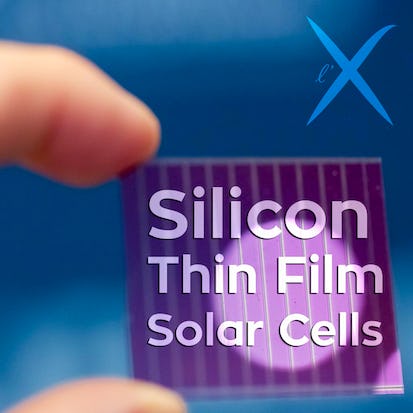- Level Expert
- Duration 5 hours
- Course by École Polytechnique
-
Offered by

About
This course consists of a general presentation of solar cells based on silicon thin films. It is the third MOOC of the photovoltaic series of Ecole polytechnique on Coursera. The general aspects of the photovoltaic field are treated in "Photovoltaic Solar Energy". And the detailed description of the crystalline silicon solar cells can be found in "Physics of Silicon Solar Cells". After a brief presentation of solar cells operation, thin film semiconductors are described here. The general properties of disordered and crystalline semiconductors are found very different, in particular in terms of band structure and doping mechanisms. Silicon thin films, generally less than 1 µm thick, are deposited from silane plasma leading to hydrogen incorporation. The growth mechanisms are discussed, in particular the capability to prepare partially crystallized thin films which appear as a mixture of nanocrystallites embedded in an amorphous tissue. The consequences of the semiconductor properties on solar cells behavior are reviewed. The optical properties of amorphous and nanocrystalline silicon are complementary. Thus the plasma process is particularly well adapted to the preparation of multijunctions, with conversion efficiencies around 13-15 %. Furthermore plasma processes allow to prepare solar cells in large area on glass or flexible substrates. Finally, it is shown that crystalline and amorphous silicon materials can be combine into heterojunctions solar cells with high efficiency conversion (about 25 %). **This course is part of a series of 3** Photovoltaic solar energy (https://www.coursera.org/learn/photovoltaic-solar-energy/) Physics of silicon solar cells (https://www.coursera.org/learn/physics-silicon-solar-cells/) Silicon thin film solar cellsModules
Solar Cell Operation
3
Assignment
- Solar Spectrum
- Solar Cell Operation
- Test: Module Power and Illumination
9
Videos
- 1. Introduction. Solar Spectrum
- 2. Solar Spectrum (cont.)
- Worked Problem - Total Irradiance
- 3. Solar Cell Fundamentals
- Worked Problem - The I-V Characteristic
- 4. Multi-junctions. Conversion Efficiency Limitations
- Worked Problem - Solar Cell under Concentration
- 5. Solar Cell Optics
- Annex 1: Interference in Thin Films
Thin Film Semiconductors
3
Assignment
- Disordered Semiconductors
- Silicon Thin Films
- Test: Thin Film Semiconductors
9
Videos
- 1. Disordered Semiconductors
- 2. Band Structure. Tight Bnding Approximation
- 3. Doping
- 4. Hydrogenated Amorphous Silicon (a-Si:H)
- 5. Nanocrystalline Silicon (nc-Si)
- Annexe 1: Tight Binding Approximation
- Annex 2 : sp3 hybridization
- Annex 3 : Growth from Silane Plasma
- Annex 4 : Growth Mechanisms of nc-Si
Thin Film Solar Cells
4
Assignment
- Silicon Thin Film Solar Cells
- Multi-junction Solar Cells
- Heterojunctions
- Test: Thin Film Silicon Solar Cells
6
Videos
- 1. Comparison between Crystalline and Amorphous Silicon
- 2. a-Si:H and Related Materials Solar Cells
- 3. Multi-junction Solar Cells
- 4. Solar Modules and Applications
- 5. Thin Crystalline Silicon Solar Cells and Heterojunctions
- Annex1. Transparent Conducting Oxides
Auto Summary
Explore the intricate world of silicon thin film solar cells with this advanced course from Ecole polytechnique on Coursera. Targeted at experts in Science & Engineering, the course delves into the unique properties and applications of silicon thin films in photovoltaic technology. Over 300 minutes, learners will uncover the differences between disordered and crystalline semiconductors, their implications on solar cell behavior, and advanced techniques like multijunctions and heterojunctions that achieve high conversion efficiencies. Available through Starter and Professional subscriptions, this course is ideal for those seeking in-depth knowledge in cutting-edge solar cell technology.

Pr. Bernard Drevillon

Erik Johnson


